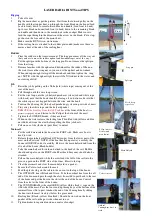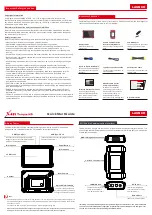
10
2.7 Drop Application with external tubing
The manual dispenser supplied with your instrument is designed for water and other liquids of
similar viscosity. Test liquids of high viscosity (e.g. glycerine, floor varnish) can not be
applied with the manual dispenser. To apply liquids of high viscosity the procedure below can
be used. This procedure can also be used for temporary testing with “unusual” liquids, as it
will not require cleaning of the dispenser.
The procedure below uses an optional syringe with tip (PN # 860 321). The same procedure
can also be used with the manual dispenser delivered with the instrument.
PLEASE NOTE! To avoid contamination it is recommended to use separate tubing for each
test liquid.
a) Hold the top section of the tubing dispenser and turn the lower
part a few turns to open the chuck inside.
b) Insert the applicator tubing into the dispenser without touching
the free end. Leave approx. 25 mm of the tubing outside the
dispensing tip.
c) Fit the other end of the tubing onto the RED syringe tip and
push the tip onto the syringe.
d) Push the plunger inside the syringe to its forward position.
e) Insert the free end of the applicator tubing into the test liquid.
DO NOT dip the dispensing tip into the liquid!
f) Pull the plunger gently backwards to fill the tubing.
DO NOT let the liquid enter the syringe tip!
g) Remove tubing end from the liquid container and pull the
plunger slightly backward to suck some air into the tubing end.
h) Wipe the outside of the tubing end clean.
i)
Pull the tubing into the dispenser until only a short end (approx. one mm)
extends outside the tip of the dispenser. Tighten the chuck gently to lock the tubing.
j) Install the dispenser in the instrument.
k) Load a specimen as described in Section 2.2.
l) Push the plunger very carefully forward until a droplet appears at the dispensing tip.
Press on top of the dispenser to apply the droplet on the specimen.
m)
Advance the specimen to a new test position. Pump out a new droplet as described in (l)
above and apply it on the surface for the first test droplet.
Fig. 2.19 Fill the tubing
(f
)
(b
)
(e
)


































